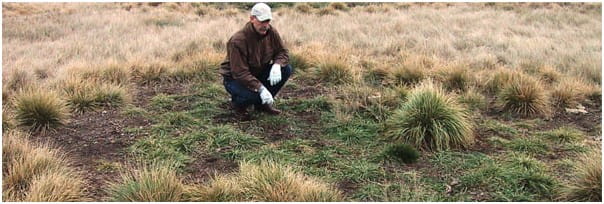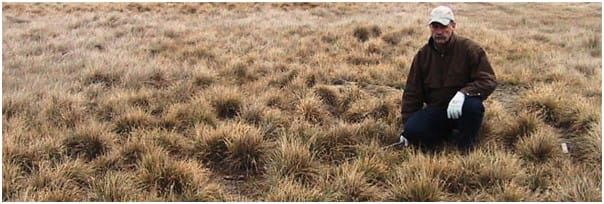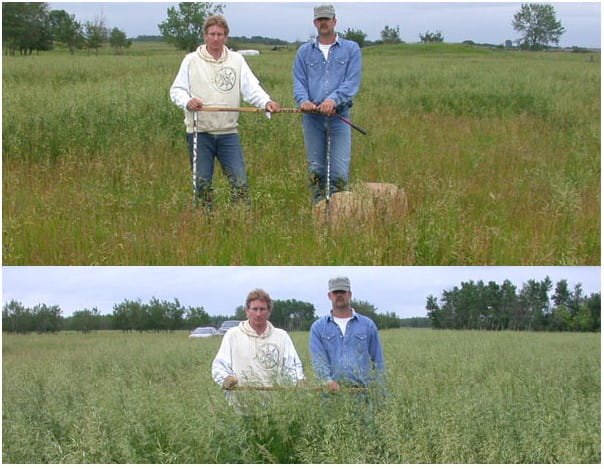Logistics of site selection
A main goal of bale grazing is to reduce winter feeding costs without compromising the health, comfort or performance of the livestock. When choosing a location, ideally the site should:
- Be easy to monitor;
- Be on or near the field(s) where the bales were made to reduce bale handling and transportation costs;
- Be on land that is already perimeter fenced or can be fenced at a low cost;
- Be on seeded perennial forage in a nutrient deficient state, resulting in a large increase in forage productivity from added nutrients;
- Have power available for electric fences to control livestock access to the bales (not needed if the fencing is solar powered);
- Have a water source if adequate soft snow is not available;
- Have wind protection for the livestock (protection can include natural bush, planted shelterbelts or portable windbreaks); and
- Have access to a handling facility if needed.
Land use
The preferred bale grazing site would be seeded perennial forage. Annual cropland is less suited and native prairie sites are not recommended for bale grazing.
After bale grazing, even with good livestock management resulting in relatively high feed utilization, there will be a significant layer of organic material left behind. This consists of manure mixed with soiled and leftover feed. Depending on the amount of snow on the site, livestock traffic may create an ice pack underneath this layer. The organic layer is effective at insulating and slowing the warming of the soil in spring, artificially creating a longer winter season.
Seeded perennial forage
Seeded pastures and hay fields are the preferred land use for bale grazing sites.
Bale grazing delivers a significant amount of nutrients to the site, especially on the points where the bales are placed. This nutrient supply is released over several years from the organic layer. Seeded perennial forage is generally the best suited vegetation for taking advantage of and utilizing this relatively high level of fertility.
Research at Western Beef Development Centre in Lanigan compared bale feeding on perennial grass pasture to traditional feeding in confinement, followed by mechanical manure spreading. The alfalfa/grass hay bales averaged 1385 pounds (lbs) with 27 pounds of nitrogen per bale. When bales were fed on pasture during winter, 34 per cent of the nitrogen in the bales was recovered by the grass during the following two growing seasons. With confinement feeding followed by mechanical manure spreading, one per cent of the nitrogen in the feed was recovered by the grass.

Ideally, the stands should have at least one rhizomatous grass species (smooth bromegrass, Kentucky bluegrass). After grazing, if a relatively thick layer of residual material remains on the spots where bales were placed, these grasses have a greater chance of growing through the layer and filling in from new shoots produced by their rhizomes. On fields dominated with bunchgrass species (crested wheatgrass, meadow bromegrass, Russian wild ryegrass), there is greater potential for "dead spots" and weed growth on the spots where bales are placed.
 Bale grazing alfalfa/grass hay on a bunchgrass pasture (Russian wild ryegrass). A three-inch layer of material was left behind after grazing. After four years, the stand is slightly thinned where bales were placed. Photo: Saskatchewan Agriculture
Bale grazing alfalfa/grass hay on a bunchgrass pasture (Russian wild ryegrass). A three-inch layer of material was left behind after grazing. After four years, the stand is slightly thinned where bales were placed. Photo: Saskatchewan AgricultureThe effect of bale grazing on legumes in a perennial stand is variable. When the residual layer after bale grazing is greater than four inches thick, alfalfa appears to be injured. When the residual layer is less than four inches, alfalfa can be enhanced. In some regions, alsike clover has been increasing on fields where bale grazing occurs. On perennial fields with a high percentage of legumes, producers are encouraged to experiment and proceed with caution.
Annual cropland
Annual cropland is somewhat less suited for bale grazing sites for several reasons:
- The layer of manure and leftover feed in the following spring may cause trash clearance problems with seeding equipment unless the residue is spread with heavy harrowing. Harrowing may or may not be effective, depending on the amount of material left over and the spacing of the bales.
- An ice layer underneath the residue may keep soil temperatures cold beyond the optimum seeding date.
- If any plastic twine remains behind, it could cause problems with the seeding equipment.
- The uneven distribution of nutrients after bale grazing would likely cause significant variation in subsequent crops.
Native prairie
Bale grazing is not recommended on native prairie sites. The primary reason for this is that bale grazing may increase the opportunity for invasive weeds and forage species to become established, through seed introduction and increased soil fertility. Secondly, native plant species evolved and produce forage under relatively low fertility conditions. Native species will not respond to increased soil fertility at the same level observed in seeded perennial forages.
Bale grazing has greater potential to spread weeds compared to feeding systems where the manure is piled, composted and spread. Composting decreases the germination rate on a high proportion of weed seeds.
It is important to be aware of the weed seed species in the bales. Although some of the seeds will be consumed and digested in the rumen, many will be trampled into the litter and soil around the bale. This is a highly fertile zone with good opportunity for weed establishment. Avoid introducing new and/or competitive weed species that have the ability to establish on a site.
Annual weeds are less of a concern than perennial weeds, but not always. Sites with sod-forming rhizomatous grass species have a greater ability to compete with weeds compared to bunchgrass pastures or annual cropland.
Soil texture, nutrient leaching and water runoff considerations
Fields or bale graze sites with coarse-textured soils (sandy, gravelly) are not preferred locations for bale grazing, due to the risk of nutrients leaching into the water table. If bale grazing is planned for these areas, consider using a lower bale density to reduce the risk of nutrient leaching. It is recommended producers avoid bale grazing on coarse textured soils above shallow aquifers.
Bale grazing should occur on a site where water runoff to surface water bodies is minimal or contained on the farm. Avoid bale grazing in riparian areas (wetlands), on steep slopes next to riparian areas, and on upland areas that drain directly into a water body used as a water source.
 The two photos above illustrate forage production two years after bale grazing took place on a low fertility, rhizomatous grass pasture (smooth bromegrass, Kentucky bluegrass). The top photo shows an area between bales where low levels of nutrients were deposited by livestock. The bottom photo shows the area that was underneath and adjacent to a bale, where high levels of nutrients were deposited by livestock. This area is now dominated by smooth bromegrass. Photos: Saskatchewan Agriculture
The two photos above illustrate forage production two years after bale grazing took place on a low fertility, rhizomatous grass pasture (smooth bromegrass, Kentucky bluegrass). The top photo shows an area between bales where low levels of nutrients were deposited by livestock. The bottom photo shows the area that was underneath and adjacent to a bale, where high levels of nutrients were deposited by livestock. This area is now dominated by smooth bromegrass. Photos: Saskatchewan AgricultureSoil fertility considerations for bale placement
Where there are variable soil conditions and/or rolling topography, producers may want to place bales on fields or target areas within a field where the nutrients, manure and residue from the bales will provide the greatest economic benefit.
One example would be placing bales on hilltops where there is shallow topsoil and low fertility. Another would be placing bales on fields with the lowest overall fertility. Avoid low lying areas and depressions with high natural fertility as excess nutrients and higher leaching rates will increase the potential for groundwater contamination.
Physical impacts on the bale graze site
The majority of bale grazing occurs during the fall on dry soils or during winter on frozen soils. In these cases, there is minimal physical impact on the soil surface and on perennial plants. When bale grazing occurs during spring thaw, there is potential for hoof damage (pugging) to the soil surface. Producers should monitor this situation and have alternative plans until the soil surface is able to support livestock traffic.
Options to minimize pugging during spring thaw are to bale graze on rhizomatous grass areas, higher elevations and south facing slopes.
Next - Bale Placement
